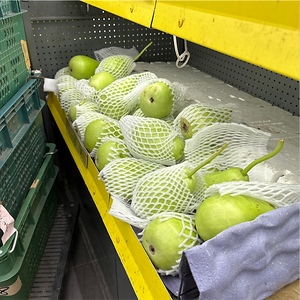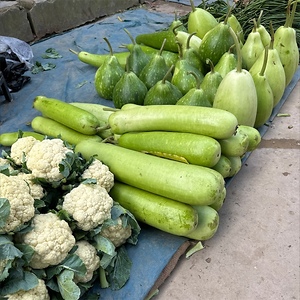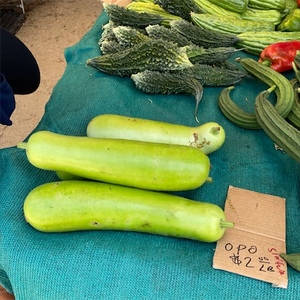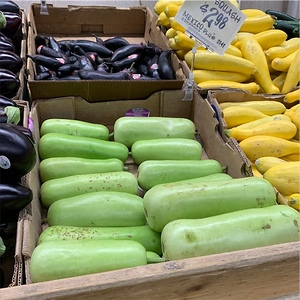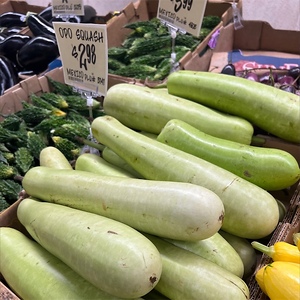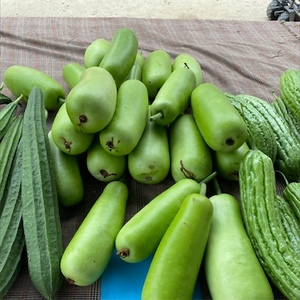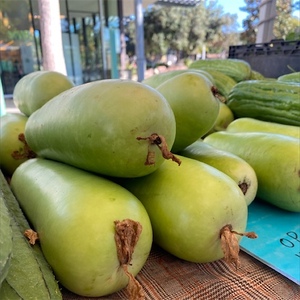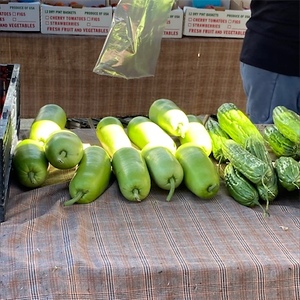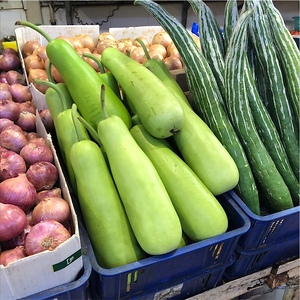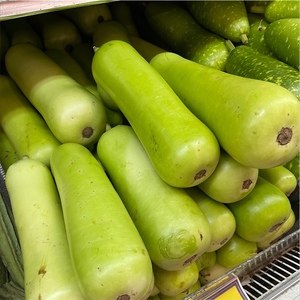

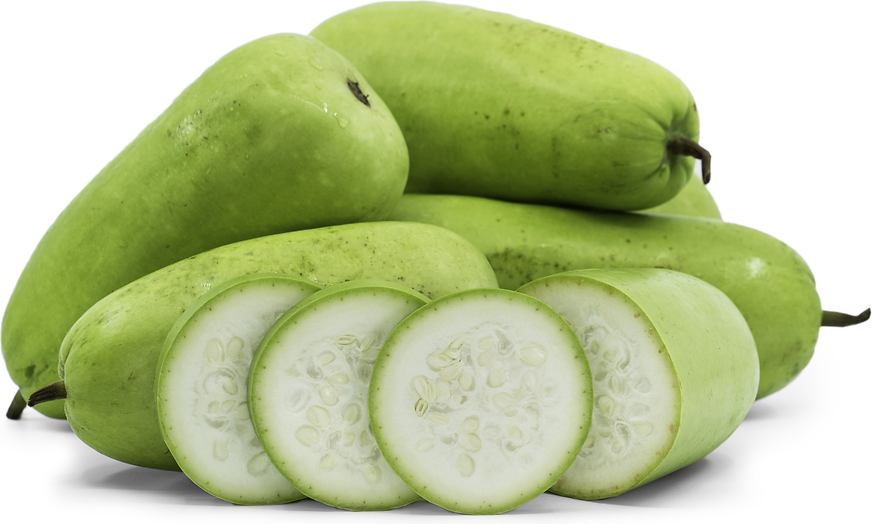
Opo Squash
Estimated Inventory, 40 lbs : 0
Description/Taste
Opo squash is a medium to large varietal, averaging 25 to 38 centimeters in length, and has an elongated, cylindrical shape with blunt, curved ends. The squashes have the ability to grow up to 91 centimeters in length, but they are sold in smaller sizes to retain a more palatable texture and flavor. The skin is semi-thin when young, becoming thicker with age, and has a smooth, taut, and somewhat tough consistency. The skin also has a pale green hue, developing yellow-green tones with maturity, and some fruits are covered in white spots. Underneath the surface, the white flesh is firm, moist, crisp, and succulent. The flesh also encases cream-colored to ivory seeds that are edible when young but become tough and hard as the squash matures. Opo squash is edible raw or cooked and has a mild, neutral, grassy, and subtly green taste.
Seasons/Availability
Opo squash is available year-round, with a peak season in the summer through early fall.
Current Facts
Opo squash, botanically classified as Lagenaria siceraria, is a widespread species belonging to the Cucurbitaceae family. The squashes grow on trailing vines that wind around trees, walls, and trellises in tropical to subtropical regions worldwide, and the squash’s hanging nature is what gives it a signature, cylindrical shape. If Opo squash vines are allowed to grow on the ground, the squashes often become more round or pyriform in appearance. Despite their squash moniker, the species is botanically a type of gourd. Opo squashes were given their squash descriptor as the fruits are prepared similarly to summer squash in culinary preparations. The species is known by several regional names worldwide, including Bottle gourds, Tasmania beans, Calabash squashes, Chinese Long squashes, Peh Poh, Lauki, Hulu, and Long squash. Opo squashes are a versatile ingredient utilized for sweet or savory dishes, and the flesh is primarily valued as a textural component in raw or cooked dishes.
Nutritional Value
Opo squash is a source of vitamin C to boost the immune system, calcium to build strong bones and teeth, and iron to develop the protein hemoglobin for oxygen transport through the bloodstream. The fruits also provide fiber to regulate the digestive tract, potassium to balance fluid levels within the body, magnesium to control nerve functions, and other nutrients, including zinc, folate, manganese, and thiamine. In natural medicines throughout Asia, Opo squashes are used in remedies to increase digestion and detox the body by clearing heat.
Applications
Opo squash has a mild, vegetal, green, and subtly sweet taste suited for fresh and cooked preparations. Young squashes can be eaten out of hand and are used similarly in recipes to zucchini. The squash can be shredded and added to salads and side dishes, sliced and served with dips, or used in batters for muffins and bread. Older Opo squashes are traditionally cooked and retain their firmness, making them ideal for use in a wide variety of dishes. Opo squashes can be simmered into soups, stews, and curries or cooked in sauces with vegetables as a main dish. They can also be stuffed with meats, fried, cooked into fritters, or slow-roasted. Opo squashes are a prevalent ingredient in Mediterranean, Indian, Filipino, Thai, and Chinese cuisines, and the flesh tends to absorb other flavors it is paired with, becoming a textural addition to cooked dishes. Opo squash pairs well with eggplant, cabbage, bitter greens, aromatics such as onions, chile peppers, ginger, and garlic, soy sauce, coconut milk, meats including pork, poultry, and pork, and seafood such as fish, shrimp, crab, and clams. Whole, unopened Opo squashes will keep for 2 to 3 weeks when stored in a cool, dry, and dark place, such as the refrigerator’s crisper drawer.
Ethnic/Cultural Info
Opo is the Chinese name for the gourd species and has been used in China for centuries. Older, more mature Opo squashes were traditionally viewed as a symbol of good health, and the dried squashes were used as a carrying case. Traveling doctors would transport their medicines in the dried squashes, and it was believed that the squashes would absorb negative energies to prevent them from harming the body. Opo squashes were also grown in various decorative molds to produce squashes of different shapes, used as cases, decorations, vases, and liquid vessels.
Geography/History
Opo squashes are descendants of squash varieties native to Africa that have been growing wild since ancient times. Squashes were carried with humans throughout the continent in the early ages and were used as water and food vessels. They were also spread to Asia and widely grown for culinary and medicinal uses. Experts believe some dried squash varieties may have been transported across the oceans by naturally floating, as the seeds can survive for over 200 days inside the fruits. These ocean squashes eventually led to the seeds being planted throughout Mexico, Central America, and South America. Scientists often dispute this theory with other concepts of migrating humans carrying the species to the Americas. Over time, Opo squashes were spread worldwide, thriving in tropical to subtropical climates with long, warm, growing seasons. Today, Opo squashes can be found in Asia, Southeast Asia, New Zealand, Australia, Africa, Europe, and the Americas and are commercially cultivated, grown in home gardens, or found in the wild.
Recipe Ideas
Recipes that include Opo Squash. One



